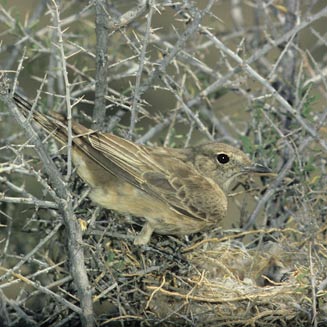|
Bradornis infuscatus (Chat flycatcher)
[=
Melaenornis infuscatus]
GrootvlieŽvanger [Afrikaans];
Lijstervliegenvanger [Dutch]; Gobemouche traquet [French];
Drosselschnšpper [German]; Papa-moscas-chasco [Portuguese]
Life
> Eukaryotes >
Opisthokonta
> Metazoa (animals) >
Bilateria >
Deuterostomia > Chordata >
Craniata > Vertebrata (vertebrates) > Gnathostomata (jawed
vertebrates) > Teleostomi (teleost fish) > Osteichthyes (bony fish) > Class:
Sarcopterygii (lobe-finned
fish) > Stegocephalia (terrestrial
vertebrates) > Tetrapoda
(four-legged vertebrates) > Reptiliomorpha > Amniota >
Reptilia (reptiles) >
Romeriida > Diapsida > Archosauromorpha > Archosauria >
Dinosauria
(dinosaurs) > Saurischia > Theropoda (bipedal predatory dinosaurs) >
Coelurosauria > Maniraptora > Aves
(birds) > Order: Passeriformes
> Family: Muscicapidae > Genus: Bradornis
Distribution and habitat
Near-endemic to southern Africa, occurring from southern
Angola through Namibia and Botswana to South Africa. It is most common in arid
Acacia savanna and Nama Karoo, as well as dry Karoo shrublands and sparse
dry woodland.
|
 |
|
Distribution of Chat flycatcher in southern Africa,
based on statistical smoothing of the records from first SA Bird Atlas
Project (©
Animal Demography unit, University of
Cape Town; smoothing by Birgit Erni and Francesca Little). Colours range
from dark blue (most common) through to yellow (least common).
See here for the latest distribution
from the SABAP2. |
Food
It mainly eats insects, doing most of its foraging from a
low perch, pouncing on prey on the ground. The following food items have been recorded
in its diet:
- Insects
- Hodotermes mossambicus (Northern harvester termite)
-
Hemiptera (bugs)
- Coleoptera
(beetles)
- ants, such as harvester ants (Messor)
-
Orthoptera (grasshoppers)
- Small reptiles
Breeding
- The nest (see image below) is a bulky, untidy bowl built of dry plant stems, twigs and
coarse grass lined with finer material such as rootlets and plant down.
Aromatic plants, such as cudweed (Gnaphalium) and everlastings (Helichyrsum),
are often used in nest construction, probably because they repel insects. It
is typically placed in a low bush which sometimes, but not always, conceals
the nest from predators.
 |
|
|
Chat flycatcher at nest with chicks. [photo Peter
Steyn ©] |
|
- Egg-laying season is basically year-round, and is thought to coincide
with rainfall, but it probably peaks around September-March.
- It lays 2-3 eggs, which are incubated solely by the female for about
14-15 days, while the male feeds her at the nest.
- The chicks are brooded for parts of their early lives and are fed by
both parents, eventually leaving the nest after about 11-14 days.
Threats
Not threatened.
References
-
Hockey PAR, Dean WRJ and Ryan PG 2005. Roberts
- Birds of southern Africa, VIIth ed. The Trustees of the John Voelcker
Bird Book Fund, Cape Town.
|
